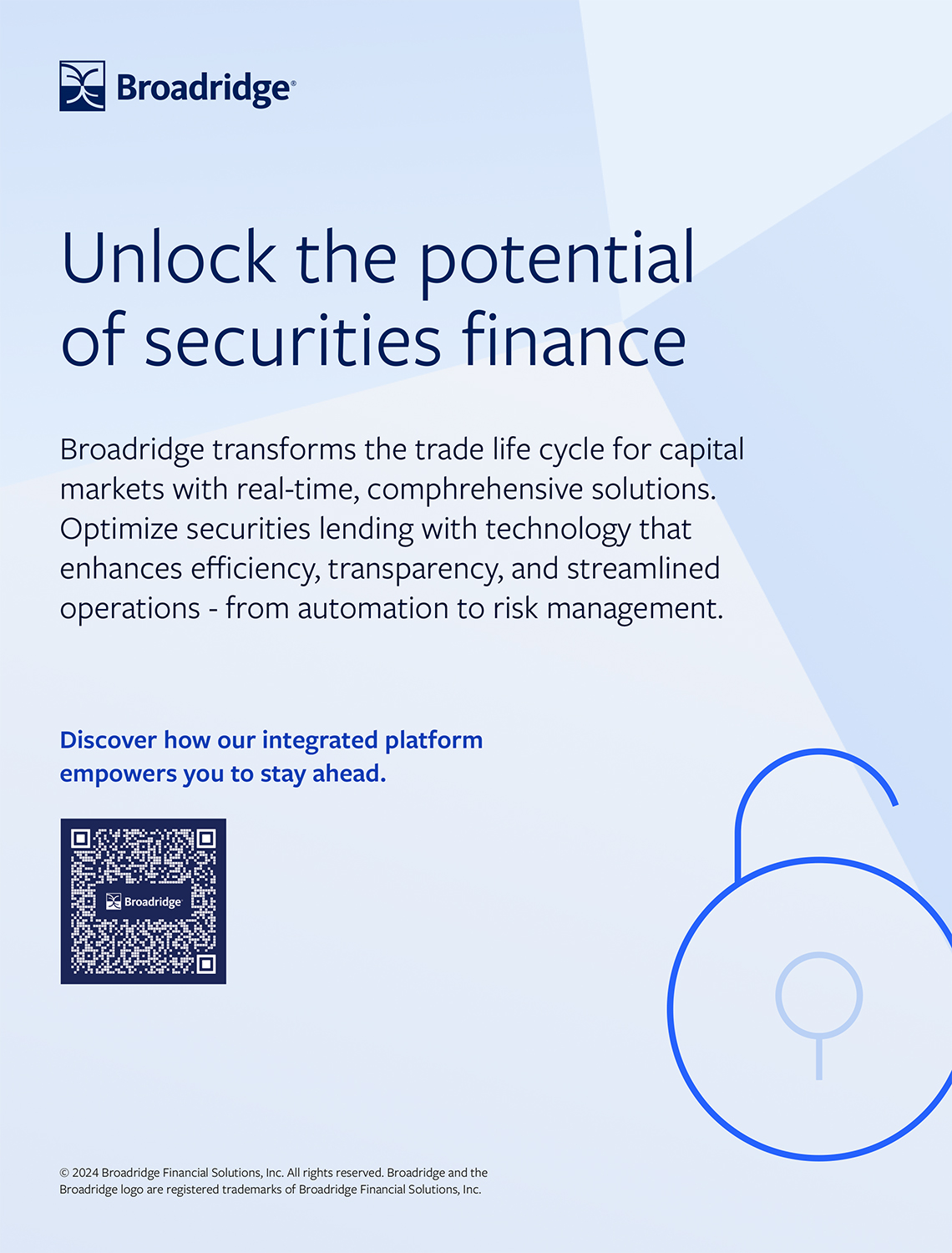IMN: Digital collateral tokens a “game changer” for collateral markets
15 September 2022 UK
 Image: immimagery/stock.adobe.com
Image: immimagery/stock.adobe.com
Technology developments in the digital asset space give rise to the possibility of digital collateral tokens, which would be a game changer for the collateral markets, according to Darren Wilson, vice president of financing and collateral solutions, business development at State Street.
Wilson made the comments during a panel entitled “The European Repo Market Outlook: Challenges and Opportunities for Investors and Repo Traders” at the IMN European Beneficial Owners’ Securities Finance & Collateral Management Conference, held in London.
Hosted by GLMX’s chief product officer Andy Wiblin, the panel discussed what opportunities lie ahead for the industry and how the industry can work toward a more efficient market.
Speakers on the panel included Morten Jacobsen, head of cash management at Norges Bank Investment Management, Stuart Day, director of product management at S&P Global Market Intelligence, and Jonathan Ford, managing director of Central Funding Group at RBC Capital Markets.
RBC Capital Market’s Ford reflected on the repo market for 2022. He said: “It is an interesting market out there. I would say, anecdotally, if you look at 2019, just looking at active traders and hedge funds, their US versus world allocation was probably somewhere around the scale of 80 per cent US / North America, 20 per cent Europe and Asia.
“That has swung around tremendously post-COVID-19, where it is probably 60/40 or 70/30 Europe/Asia. You can see it in the government bond space, and you can see it, particularly, on the short side.”
Ford said he has noticed a dynamic in the market where there is not necessarily direct consumption or need for leverage, but there are second order leverage on shorts, because “if you have got to lend it, you have got to borrow it, to borrow you have got to consume balance sheet — either to borrow it, or to give collateral to the lenders that you are borrowing it from.” As a liquidity provider, Ford added there needs to be compensation for that.
He continued to note the opportunities in the market going forward. He expressed that there are a multitude of things within the industry that need to be improved to ease and speed the velocity of collateral, including data and automation.
“From the data management side, in terms of the collateral matching programmes and the collateral management vendors, in terms of the legal side of the equation, there are so many parts of the business that are not efficient or can be further improved,” Ford explained.
The panel also highlighted that the liquidity pools in the repo markets are fairly fragmented, and are not as developed as other marketplaces.
However, State Street’s Wilson noted: “Technology can play an enabling role here, to connect alternative liquidity pools and repo programmes, potentially with one platform interface and provide greater connectivity between repo market participants, supporting price discovery and giving access to different sources of liquidity.”
The velocity of collateral is set to increase as securities market settlement transitions from T+2 and T+1 and this will have a large impact on the trading process and operating models, Wilson explained. According to the panel, this will speed up the availability of collateral and enable shorter trading lifecycles.
Wilson concluded: “Thinking further ahead, technology developments in the digital asset space give rise to the possibility of digital collateral tokens which would enable real-time settlement of collateral obligations. That would be a game changer in collateral markets, and it may help facilitate interoperability of collateral assets held in different locations.”
Wilson made the comments during a panel entitled “The European Repo Market Outlook: Challenges and Opportunities for Investors and Repo Traders” at the IMN European Beneficial Owners’ Securities Finance & Collateral Management Conference, held in London.
Hosted by GLMX’s chief product officer Andy Wiblin, the panel discussed what opportunities lie ahead for the industry and how the industry can work toward a more efficient market.
Speakers on the panel included Morten Jacobsen, head of cash management at Norges Bank Investment Management, Stuart Day, director of product management at S&P Global Market Intelligence, and Jonathan Ford, managing director of Central Funding Group at RBC Capital Markets.
RBC Capital Market’s Ford reflected on the repo market for 2022. He said: “It is an interesting market out there. I would say, anecdotally, if you look at 2019, just looking at active traders and hedge funds, their US versus world allocation was probably somewhere around the scale of 80 per cent US / North America, 20 per cent Europe and Asia.
“That has swung around tremendously post-COVID-19, where it is probably 60/40 or 70/30 Europe/Asia. You can see it in the government bond space, and you can see it, particularly, on the short side.”
Ford said he has noticed a dynamic in the market where there is not necessarily direct consumption or need for leverage, but there are second order leverage on shorts, because “if you have got to lend it, you have got to borrow it, to borrow you have got to consume balance sheet — either to borrow it, or to give collateral to the lenders that you are borrowing it from.” As a liquidity provider, Ford added there needs to be compensation for that.
He continued to note the opportunities in the market going forward. He expressed that there are a multitude of things within the industry that need to be improved to ease and speed the velocity of collateral, including data and automation.
“From the data management side, in terms of the collateral matching programmes and the collateral management vendors, in terms of the legal side of the equation, there are so many parts of the business that are not efficient or can be further improved,” Ford explained.
The panel also highlighted that the liquidity pools in the repo markets are fairly fragmented, and are not as developed as other marketplaces.
However, State Street’s Wilson noted: “Technology can play an enabling role here, to connect alternative liquidity pools and repo programmes, potentially with one platform interface and provide greater connectivity between repo market participants, supporting price discovery and giving access to different sources of liquidity.”
The velocity of collateral is set to increase as securities market settlement transitions from T+2 and T+1 and this will have a large impact on the trading process and operating models, Wilson explained. According to the panel, this will speed up the availability of collateral and enable shorter trading lifecycles.
Wilson concluded: “Thinking further ahead, technology developments in the digital asset space give rise to the possibility of digital collateral tokens which would enable real-time settlement of collateral obligations. That would be a game changer in collateral markets, and it may help facilitate interoperability of collateral assets held in different locations.”
← Previous technology article
Deutsche Börse confirms creation of first digital instruments in D7 simulation environment
Deutsche Börse confirms creation of first digital instruments in D7 simulation environment
NO FEE, NO RISK
100% ON RETURNS If you invest in only one securities finance news source this year, make sure it is your free subscription to Securities Finance Times
100% ON RETURNS If you invest in only one securities finance news source this year, make sure it is your free subscription to Securities Finance Times



